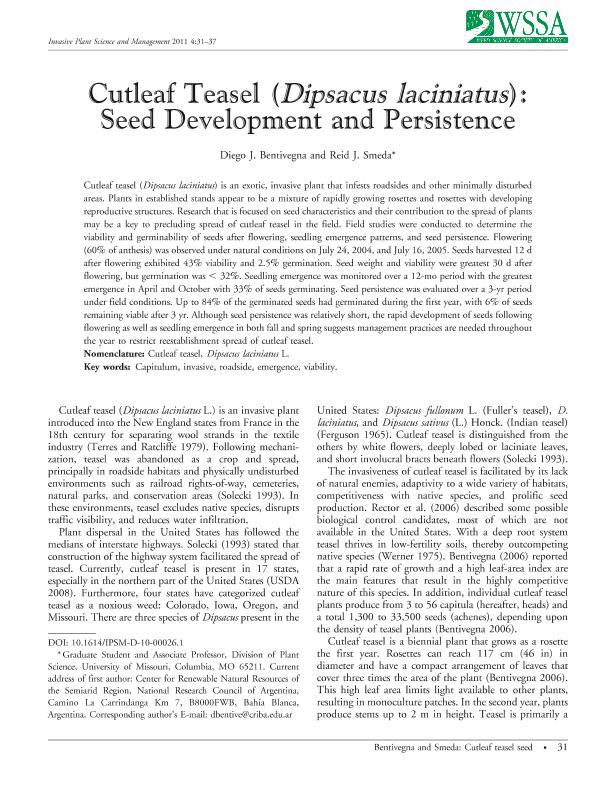Mostrar el registro sencillo del ítem
dc.contributor.author
Bentivegna, Diego Javier

dc.contributor.author
Smeda, Reid J.

dc.date.available
2017-05-09T19:04:17Z
dc.date.issued
2011-01
dc.identifier.citation
Bentivegna, Diego Javier; Smeda, Reid J.; Cutleaf teasel (Dipsacus laciniatus): seed development and persistence; Weed Science Society of America; Invasive Plant Science and Management; 4; 1; 1-2011; 31-37
dc.identifier.issn
1939-7291
dc.identifier.uri
http://hdl.handle.net/11336/16161
dc.description.abstract
Cutleaf teasel (Dipsacus laciniatus) is an exotic, invasive plant that infests roadsides and other minimally disturbed areas. Plants in established stands appear to be a mixture of rapidly growing rosettes and rosettes with developing reproductive structures. Research that is focused on seed characteristics and their contribution to the spread of plants may be a key to precluding spread of cutleaf teasel in the field. Field studies were conducted to determine the viability and germinability of seeds after flowering, seedling emergence patterns, and seed persistence. Flowering (60% of anthesis) was observed under natural conditions on July 24, 2004, and July 16, 2005. Seeds harvested 12 d after flowering exhibited 43% viability and 2.5% germination. Seed weight and viability were greatest 30 d after flowering, but germination was <32%. Seedling emergence was monitored over a 12-mo period with the greatest emergence in April and October with 33% of seeds germinating. Seed persistence was evaluated over a 3-yr period under field conditions. Up to 84% of the germinated seeds had germinated during the first year, with 6% of seeds remaining viable after 3 yr. Although seed persistence was relatively short, the rapid development of seeds following flowering as well as seedling emergence in both fall and spring suggests management practices are needed throughout the year to restrict reestablishment spread of cutleaf teasel. © Weed Science Society of America.
dc.format
application/pdf
dc.language.iso
eng
dc.publisher
Weed Science Society of America
dc.rights
info:eu-repo/semantics/openAccess
dc.rights.uri
https://creativecommons.org/licenses/by-nc-sa/2.5/ar/
dc.subject
Capitulum
dc.subject
Invasive
dc.subject
Roadside
dc.subject
Emergence
dc.subject
Viability
dc.subject.classification
Agronomía, reproducción y protección de plantas

dc.subject.classification
Agricultura, Silvicultura y Pesca

dc.subject.classification
CIENCIAS AGRÍCOLAS

dc.title
Cutleaf teasel (Dipsacus laciniatus): seed development and persistence
dc.type
info:eu-repo/semantics/article
dc.type
info:ar-repo/semantics/artículo
dc.type
info:eu-repo/semantics/publishedVersion
dc.date.updated
2017-05-02T18:58:22Z
dc.identifier.eissn
1939-747X
dc.journal.volume
4
dc.journal.number
1
dc.journal.pagination
31-37
dc.journal.pais
Estados Unidos

dc.journal.ciudad
Lawrence
dc.description.fil
Fil: Bentivegna, Diego Javier. University Of Missouri; Estados Unidos. Consejo Nacional de Investigaciones Científicas y Técnicas. Centro Científico Tecnológico Conicet - Bahía Blanca. Centro de Recursos Naturales Renovables de la Zona Semiarida. Universidad Nacional del Sur. Centro de Recursos Naturales Renovables de la Zona Semiarida; Argentina
dc.description.fil
Fil: Smeda, Reid J.. University Of Missouri; Estados Unidos
dc.journal.title
Invasive Plant Science and Management
dc.relation.alternativeid
info:eu-repo/semantics/altIdentifier/doi/http://dx.doi.org/10.1614/IPSM-D-10-00026.1
dc.relation.alternativeid
info:eu-repo/semantics/altIdentifier/url/https://www.cambridge.org/core/journals/invasive-plant-science-and-management/article/cutleaf-teasel-dipsacus-laciniatus-seed-development-and-persistence/AE5B65C5483D8A297D5574EA39E97D4D
Archivos asociados
